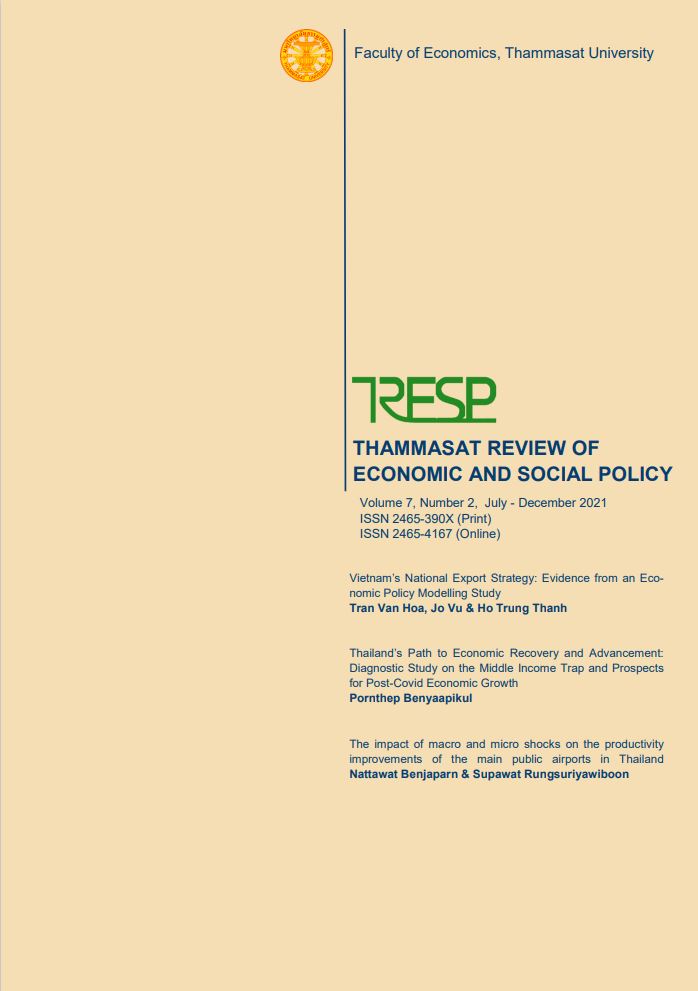Vietnam’s National Export Strategy: Evidence from an Economic Policy Modelling Study
Keywords:
Vietnam's exports and growth, economic integration theory, econometric modelling, national strategic economic and trade policyAbstract
This paper is a rigorous study of Vietnam’s exports determination and its causal relationship to the country’s growth, and addresses growing concerns regarding Vietnam’s growth path. The objective is to provide substantive evidence and credible inputs from a demand-side macroeconomic perspective. Significantly for Vietnam, an important open and transition economy in Asia, the study is carried out from an economic integration growth framework. Specifically, a multi-simultaneous equation model of Vietnam’s endogenous growth and exports determination is developed. The model innovatively incorporates gravity theory and classical consumer demand contributors, Ironmonger-Lancaster new commodity attributes and Johansen policy impact add- and sub-factors (i.e., reforms and crises) explicitly in its economic integration structure. Empirical findings also provide significant evidence to support a focus on strategies affected by external or demand side determinants of Vietnam’s exports and the influence of crises and reforms. The research will contribute to advances in the international trade literature and the findings provide useful insights and much needed evidence-based inputs on the determination and contributors of Vietnam’s exports to the national economy. These strategic recommendations are useful to key stake-holders such as policy-makers, government and academic researchers, and business analysts for national export strategic policy analysis and practical implementation.
References
Asian Development Bank (2021). https://www.adb.org/publications/series/keyindicators-for-asia-and-the-pacific. Accessed 25 Apr 2021.
Allen, R. G. D. (1960). Mathematical Analysis for Economists. London: Macmillan.
Easterly, W. (2007). Was Development Assistance A Mistake?. American Economic Association Meeting, Chicago, 5-7 January 2007.
Engle, R. F. & Granger, C.W.J. (1987). Co-integration and Error Correction: Representation, Estimation and Testing. Econometrica, 55, 251-276.
ERS-USDA (2021). International Macroeconomic Data Set. https://www.ers.usda.gov/data-products/internationalmacroeconomic-data-set/. Accessed 10 Apr 2021.
Frankel, J. A. & Romer, D. (1999). Does Trade Cause Growth?. American Economic Review,89, 379-399.
Friedman, M. (1953). Essays in Positive Economics. Chicago: University of Chicago Press,
Granger, C. W. J. (1969). Investigating Causal Relations by Econometric Models and Cross-Spectral Methods. Econometrica, 37, 424-438.
International Monetary Fund (2021). Special Series on COVID-19, https://www.imf.org/en/Publications/SPROLLs/covid19-special-notes. Accessed 3 July 2021.
Ironmonger, D. S. (1972). New Commodities and Consumer Behaviour. University of Cambridge, Department ofApplied Economics Monograph No. 20, Cambridge: Cambridge University Press.
International Trade Centre (2021). National Export Strategy. Hanoi.
Johansen, L. (1982). Econometric Models and Economic Planning and Policy: Some Trends and Problems, in M. Hazewinkle & A. H. G. Rinnooy Kan (eds.), Current Developments in the Interface: Economics, Econometrics, Mathematics, Boston: Reidel. 91-122.
Kydland, F. E. (2006). Quantitative Aggregate Economics. American Economic Review, 96(5), 1373-1383.
Lancaster, K. J. (1966). A New Approach to Consumer Theory. Journal of Political Economy,84, 132-157.
Narayan, S. & Nguyen, T. T. (2019). Are Exports More Responsive to Clean or Dirty Energy? The Case of Vietnam’s Exports to 54 Countries, Energies, 12, 1558; doi:10.3390/en12081558
Nguyen, M. H., Do H. H., & Nguyen, M. H. (2018). Analysing the Effects of the Exporting on Economic Growth in Vietnam, DOI: 10.1007/978-3-319-73150-6_47
Nguyen, T. X. & Xing, Y. (2008). Foreign Direct Investment and Exports: The Experience Vietnam. Economics of Transition and Institutional Change, 16(2), 183-197.
Pindyck, R. S. & Rubinfeld, D. L. (1998). Econometric Models and Economic Forecasts. Sydney: McGrawHill.
Sala-i-Martin, X. (1991). Comment. In Blanchard, O. J. and S. Fischer (eds.), NBER Macroeconomic Annual 1991, Cambridge, MA: MIT Press, 368-378.
Stone, R. (1988). Progress in Balancing the National Accounts. In Ironmonger, D. S., Perkins, J. O. N. & Tran, V. H. (eds.), National Income and Economic Progress: Essays in Honour of Colin Clark, London: Macmillan.
Thanh, N. N. & Kalirajan, K. (2005). The Importance of Exchange Rate Policy in Promoting Vietnam's Exports, Oxford Development Studies, 33(4), 511-527.
Tran, V. H. (1992). Modelling Output Growth: A New Approach. Economics Letters, 38, 279-284.
Tran, V. H. (2002). Economic Crisis Management. Mass.: Edward Elgar.
Tran, V. H. (2004). Korea’s Trade, Growth of Trade and the World Economy in Post-crisis ASEAN+3 Free Trade Agreement: An Econometric and Policy Analysis. Journal of the Korean Economy, 5(2), 73-108.
Tran, V. H. (2005). Modelling the Impact of China’s WTO Membership on Its Investment and Growth: A New Flexible Keynesian Approach (with Comment). In G.S. Heiduk and Karyiu Wong (eds). WTO and World Trade, New York: Physica-Verlag.
Tran, V. H. (2007). Causal Empirics and Political Economy of Official Development Assistance and Development in Asia: The Case of Vietnam. Journal of the Korean Economy, 8(1), 91-119.
Tran, V. H. (2019a). Economic Impact of Tourism on IORA Countries: The Case of India and Mauritius. Journal of Indian Ocean Rim Studies, 2(1), 1-18.
Tran, V. H. (2019b), Recent Economic Trends in the Asia Pacific Region, The Far East and Australia 2019, Europa Publications. UK.
Tran, V. H. (2020), Performance of Foreign Direct Investment Enterprises in Developing Economies: The Case of Vietnam Redux’, Thammasat Review of Economic and Social Policy, 6(2), 6-32.
Tran, V. H. & Limskul, K. (2013). Economic Impact of CO2 Emissions on Thailand's Growth and Climate Change Mitigation Policy: A Modelling Analysis.
Economic Modelling, 33, 351-358.
Tran, V. H. & Vu, J. (2018). Economic Impact of Vietnam’s Tourism on Australia: An Econometric Study. International Journal of Management and Applied Science, 4(9), 41-49
Tran, V. H., Turner, L. & Vu, J. (2018). Economic Impact of Chinese Tourism on Australia: A New Approach. Tourism Economics, 24(6), 677-689.
Tran V. H. & Vu, J. (2020). Contribution of Chinese and Indian Tourism to Australia: A Comparative Econometric Study. Archives of Business Research, 8(1), 107-120.
Tran V. H., Vu, J. & Pham, Q. T. (2020). Vietnam’s Sustainable Tourism and Growth: a New Approach to Strategic Policy Modelling, National Accounting Review, 2(4), 324-336.
United Nations Conference on Trade and Development (2021). Data Center. https://unctadstat.unctad.org/wds/ReportFolders/report Folders.aspx?sCS_ChosenLang=en or http://unctadstat.unctad.org/EN/. Accessed 10 Apr 2021.
VIOIT (2021a). Vietnam’s Goods Import-Export Strategy for the Period of 2021-2030. Ministry of Industry and Trade, Hanoi.
VIOIT (2021b). Summary of the Strategy Issues. Ministry of Industry and Trade Hanoi.
World Trade Organization (2021). Regional Trade Agreements. https://www.wto.org/english/tratop_e/region_e/region_e.htm. Accessed 2 Apr 2021.



